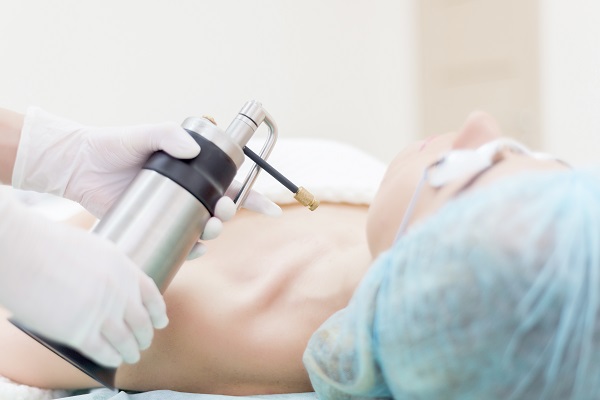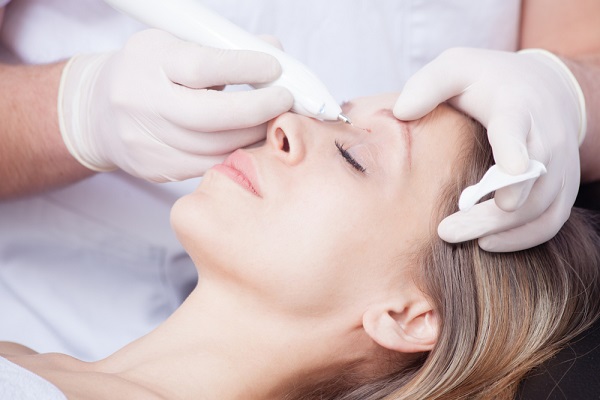At a minimum, warts can make your skin aesthetically unappealing. In extreme cases, the condition signals something more ominous. Warts result from a virus known as HPV, which is an abbreviation for human papillomavirus. Here, we discuss some common wart removal surgery techniques, the theory behind them, the side effects and risks, and alternatives. Whether you go with surgery or an alternative, a physician will generally have involvement in the treatment.

What Is Cryotherapy?
Cryotherapy relies upon nitrogen at temperatures approaching 321 degrees Fahrenheit below zero to damage the wart. Specifically, the cold treatment destroys the tissue around the warts and stops blood flow to the area. The immune system then activates to lead to the eventual healing of the area.
As a preliminary step, the surgeon may cut some of the wart with a small knife. This is especially if the warts have a cauliflower appearance. Due to the knife and nitrogen, you will get some anesthesia to numb the area and at least delay the pain until after the surgery.

A cotton swab or spray can apply the nitrogen to your skin. By design, the nitrogen forms a blister. During this stage, you may experience redness and pain. With blistering comes scabbing and the breakdown of the wart. As a result, resist the urge to scratch or remove the scab. However, if it breaks or you see fluid, promptly clean the area to avoid infection by the HPV or other viruses and bacteria.
Cryotherapy does not promise quick or easy results. In addition to some pain, you’ll have repeated trips to the surgeon. A typical regimen of cryotherapy lasts up to twelve weeks, with one visit every three weeks and four visits in all.
Normally, the best candidates for cryotherapy have light skin. Those with darker skins may have visible scars at the end of cryotherapy. Other side effects may include headaches if the warts to be removed appear on the forehead.
What Is Laser Wart Removal Surgery?
With warts that prove hard to remove because of persistence or location, laser surgery becomes an option. Sometimes, the physician will employ it as a last resort. Lasers emit an intense, narrow beam of light. In compact discs and digital video discs, the beam results in sound and images. For warts and other bumps on the skin, lasers burn and destroy the tissue involved.
Physicians generally employ a pulsed-dye laser. The theory consists of depriving the wart of the blood that sustains it. From the laser comes the light and heat that destroys the vessels. When the vessels in the wart disintegrate, the blood that sustains the wart disappears and the wart reaches its death. When successful, the laser surgery also claims the virus that caused the warts.

For certain types of warts or patients, your doctor may opt for other types of laser procedures. Carbon dioxide lasers are used to remove warts in fingernails and toenails, otherwise known as periungual warts. The two stages of the carbon dioxide procedure consist of a more focused light to remove the top of the wart and a less focused one to eliminate the remainder. With carbon dioxide comes more scarring. Erbium targets a much smaller area and usually doesn’t leave scars. Children with warts are often candidates for erbium procedures.
What Happens After Wart Removal Surgery?
Elimination of the wart does not necessarily mean you can declare good riddance to them for good. Warts exist because of the HPV virus, short for human papillomavirus. HPV is a common virus, with nearly 80 percent of people getting this virus at some point. As people use common showers or restrooms, especially at pools or water parks, they heighten their risk of warts due to the moist environments.
The moisture typical of genital areas, especially around the groin, vagina, and anus, allow genital warts to recur even after their removal.
Aside from the risk of repeated warts, those who have wart removal surgery must deal with pain and scars. As to the former side effect, ibuprofen or aspirin can afford some relief. For scars, resist the temptation to pick or rub, or else you face bleeding or additional infection.
Postoperative care often involves preventing infection and other complications. The approaches depend on the type of surgery, though some will apply to either kind:
- Leave the blisters after cryotherapy alone if at all possible. Should they continue to bother, ask your doctor about a sterile needle to burst them.
- Keep the area of the removal open, especially in the second day after cryotherapy. Covering the area may prevent the scabbing that is the essential goal of the surgery.
- Gently clean and dry the areas of the removal.
Wart Removal Surgery Cost
Check with your insurance for coverage of a wart removal procedure. Depending on your plan, you may have the entire procedure or a sizable part of it paid by insurance if a physician recommends it to treat warts.
When you don’t have the benefit of insurance, expect to pay between $250 and $600 for treatments. Laser treatments may prove less expensive, beginning as low as $100. Where you fall on the spectrum of wart removal surgery costs depends on the size and number of warts and the number of repeat procedures.
Are There Alternatives to a Wart Removal Procedure?
The surgical approaches of laser, cryotherapy, and others come into play when these alternatives do not work for reasons such as the size, number, or location of the warts:
- Salicylic acid: This has the same aim as cryotherapy, which is causing the wart to peel. By disintegrating the top, moisture forms and eventually causes the wart to disappear. Due to the potency of the acid, avoid contact with the face or genital areas.
- Ointments: For genital warts, your physician might prescribe imiquimod, which has antiviral properties.
- Trichloroacetic acid: With its chemical properties comes the ability to burn warts in the genital or internal areas.
Having warts surgically removed may take several attempts and often leave some pain and scaring. If you observe proper post-surgical care, you can lessen the chances of developing more infections or having to undergo it again. In many cases, wart removal surgery and other techniques afford removal of warts, but not a guarantee that they won’t come back.

Leave a Comment